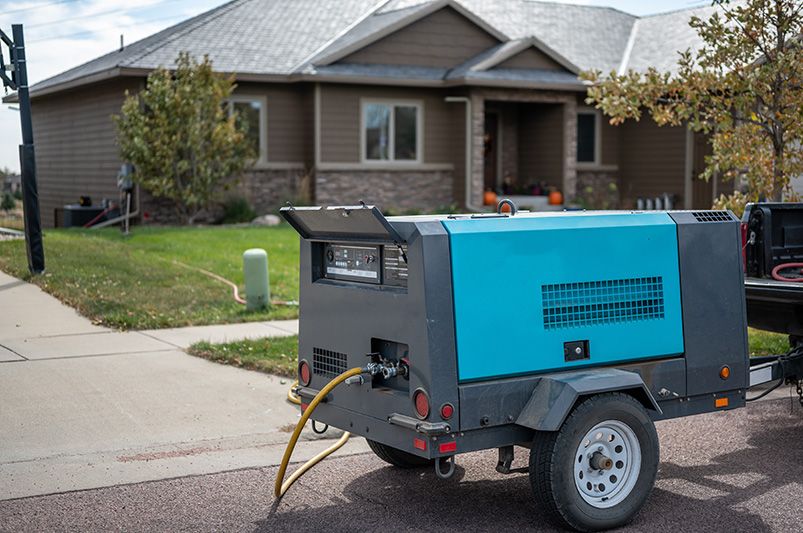
Winterize The Sprinkler System: Expert Guide
Published: 22/10/2024 | Updated: 22/10/2024
Key Highlights
- Winterizing your sprinkler system is crucial to prevent costly repairs caused by frozen pipes and fittings.
- The process involves shutting off the water supply, draining the system, and insulating exposed components.
- You can winterize your system yourself or hire a professional, especially for complex methods like blow-out draining.
- Essential tools include a manual drain valve, possibly an air compressor, and insulation materials.
- Remember to consult your system's user manual and seek professional help if needed.
Introduction
As the cold weather gets closer, you need to protect your sprinkler system from winter. Winterizing your sprinkler system is very important for homeowners in colder areas. This process has a few main steps to make sure no water is left in the system. If water stays in the system, it could freeze, expand, and create damage. Winterizing your sprinkler system can help you avoid costly repairs and keep it ready for next spring.


Understanding the Importance of Winterizing Your Sprinkler System
Imagine waking up one morning after a cold night. You find your lawn wet and parts of your sprinkler system are broken. This can happen if you don't winterize your sprinkler system.
When water freezes, it expands. If water stays in your sprinkler system when the temperature drops, it can cause pipes to crack. Fittings can break, and sprinkler heads can burst. Winterizing your system properly makes sure all the water is removed. This protects your sprinkler system and saves you from trouble in the spring.

The Risks of Not Winterizing
Failing to prepare your sprinkler system for winter can cause many problems. The most serious problem is the chance of expensive repairs. When water freezes in pipes, it expands. This puts a lot of pressure on the metal, causing cracks or even breaks. Fixing or replacing these damaged parts can cost a lot of money.
Also, if you don’t winterize your system, you may damage important parts like the backflow device. The backflow device stops dirty water from flowing back into your home’s water supply. If this device is broken, it may harm your clean water source and lead to costly repairs or replacements.
How much damage might occur also depends on how deep the frost goes in your area. The deeper the frost, the higher the risk of damage to underground pipes and parts. Even if you live in a place with mild winters, it is always smart to winterize your sprinkler system.
Benefits of a Properly Winterized Sprinkler System
Properly getting your sprinkler system ready for winter has many benefits. First, it gives you peace of mind. You know your investment is safe from winter damage. You can relax during the cold months, knowing your system will work well in spring.
Also, winterization helps your sprinkler system last longer. By stopping freezing water from causing damage, you can extend the life of the pipes, valves, and sprinkler heads. This type of maintenance means you won't have to replace parts early or face unexpected system breakdowns.
Finally, a well-winterized system protects your water supply. By making sure all pipes are dry and the backflow device is secure, you lower the chance of dirty water getting into your home's plumbing. This is important for keeping a safe and healthy water supply for you and your family.
Preparing to Winterize Your Sprinkler System
Before you start, collect the tools and equipment you need. This might be a little different based on your system, so it’s smart to check your user manual. It will help you know what you need for your model.
Usually, you will need basic tools like a wrench and pliers to work with valves. Don't forget safety goggles to protect your eyes while you work. Having all your tools ready makes the winterization process easier and quicker.

Essential Tools and Equipment for Winterization
To winterize your sprinkler system, you need to get some important tools. First, find a manual drain valve key if your system has manual drains. Next, an air compressor is recommended to drain thoroughly, but it's optional. You'll also want insulation materials like foam pipe insulation or insulation tape.
The manual drain valve helps you to release water from certain points in the system. An air compressor can push out any remaining water, especially from underground pipes. Insulation materials protect the exposed parts from freezing weather.
By gathering these tools beforehand, you can winterize your sprinkler system clearly and easily.
When to Start the Winterization Process
Timing is very important when preparing your sprinkler system for winter. You should start the process before the first hard frost arrives. This usually happens in October for many places, but it is best to check your local weather forecast.
If you wait too long, the water can freeze in the pipes. This can lead to costly repairs. However, if you winterize too early while the ground is still warm, it can cause fungal growth in the system.
So, take action early. By winterizing your sprinkler system on time, you can protect it during the winter months and ensure it is ready to use when spring comes back.
Step-by-Step Guide to Winterizing Your Sprinkler System

Now that you have your tools ready, it is time to prepare your sprinkler system for winter. This may seem hard, but you can do it easily by following a few simple steps. Use this guide to help you winterize properly.
Check your system's user manual for any special instructions or changes. Safety is important, so wear the right protective gear like safety goggles when you use compressed air or work with valves.
Step 1: Shut Off the Water Supply
The first step is to turn off the water supply to your sprinkler system completely. Find the main shut-off valve. You can usually find it near your water meter. This valve controls the water flow to the entire system.
After you find the main valve, turn it clockwise until it is fully closed. This action will stop any more water from entering the system. If you have a separate valve for your irrigation system, be sure to close that one too.
Also, check for backflow preventers on your system. These devices stop dirty water from coming back into your home's water supply. If you have backflow preventers, you should close their isolation valves to keep them out of the process.
Step 2: Drain the System
With the water supply turned off, the next step is to get rid of any remaining water in the system. Most sprinkler systems have manual drain valves located at low points. These are usually found at the ends of lateral lines.
To drain the system, open these drain valves slowly. This allows the water to flow out. You might need a wrench or pliers to fully open the valves. Remember, water pressure can build up in the system. So, open the valves gradually to prevent sudden bursts of water.
When the water stops coming from the drain outlets, close the valves tightly. This keeps out any debris or insects from entering. If your system has an automatic drain feature, activate it according to the manufacturer's instructions.
Step 3: Blow Out Remaining Water (Optional)
Using compressed air to blow out remaining water from your sprinkler system is important. It helps to prevent damage during the winter months. You can connect an air compressor to your system. This will push out any leftover water from the pipes, sprinkler heads, and valves. This step makes sure your system is fully dry. It reduces the chance of frozen or burst pipes. Even though this step is optional, it can protect you from costly repairs. It also ensures a smooth start next spring. Remember to follow the manufacturer's guidelines for air pressure and techniques.
Step 4: Insulate Above-Ground Components
The last step to prepare your sprinkler system for winter is to cover any parts that might get damaged by frost. This includes backflow preventers, pipes, valves, and other pieces above the ground.
Use foam pipe insulation sleeves or wraps to shield those exposed pipes from freezing cold. Make sure to hold the insulation in place with insulation tape or zip ties. Pay special attention to backflow preventers, making sure they are well-insulated around the bonnet and test cocks.
By adding this extra layer of protection, you help keep vulnerable components safe from tough winter weather. This ensures they will be in good shape for the next season.
Conclusion
Properly getting your sprinkler system ready for winter is important to avoid expensive damage. If you don’t do this, you may face freezing and cracking that leads to costly repairs in the spring. By following a few easy steps, you can protect your system and keep it in great shape. First, turn off the water supply. Next, drain the system and insulate any above-ground parts. For better winterization, think about blowing out any remaining water. Taking time to prepare now will help your sprinkler system last longer and prevent problems later. Happy winterizing!
Frequently Asked Questions
Can I winterize my sprinkler system without professional help?
Yes, you can winterize a sprinkler system by yourself. You can drain the system with the manual drain valve. You can also use an air compressor that connects to the hose bib. If you are not sure how to do it, it is a good idea to ask a professional for help.
How often should I winterize my sprinkler system?
Winterizing your sprinkler system should happen every year. It is best to do this before the first frost arrives. This helps protect your sprinkler from freezing temperatures in the winter months.
What are the signs of an improperly winterized sprinkler system?
Signs that winterization was not done properly include leaks, broken pipes, faulty sprinkler heads, and problems with the backflow device. If these issues are not fixed quickly, they can lead to costly repairs. A common cause of these problems is residual water left in the system.
Is it necessary to winterize in all climates?
Winterization is very important in places where it gets really cold. This is when the frost level goes below the depth of your sprinkler system. If you live in a warmer area that does not have frost, you might not need to winterize your sprinkler.
Can winterizing my system improve its longevity?
Winterizing is an important way to take care of your system. It helps your system last longer. By doing this, you stop damage from freezing water. This keeps the pipes, valves, and sprinkler heads in good shape for many years. It saves you money by avoiding costly repairs and the need to replace things early.
Need Assistance for a Complete Landscape Makeover?
Shrubhub’s landscape design packages can significantly transform the lives of homeowners by delivering customized, professional landscaping plans tailored to their unique space and personal style. With the ease of online collaboration, you are guided step-by-step through a design process that fundamentally reshapes your outdoor environment. The result is an aesthetically pleasing and functional outdoor living area that maximizes the potential of your property.


